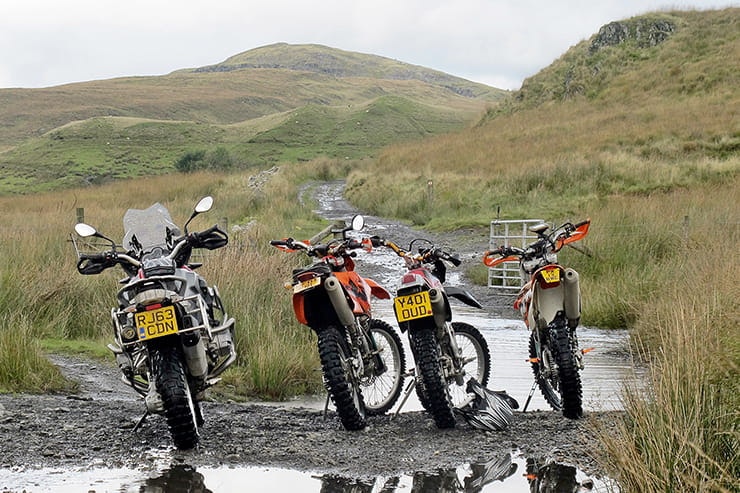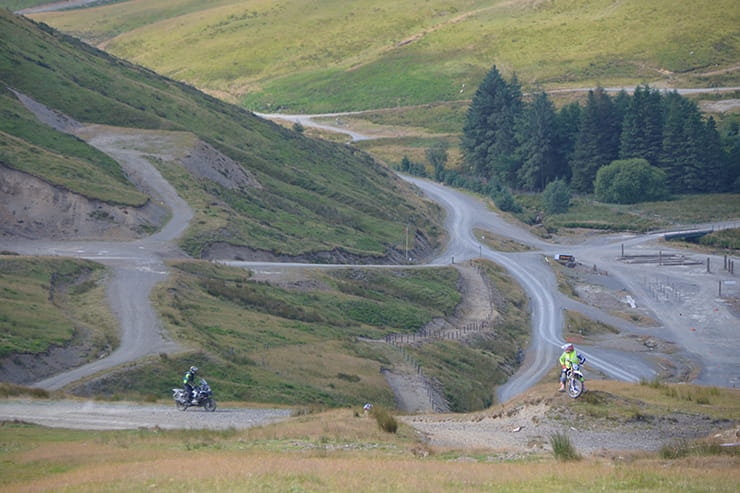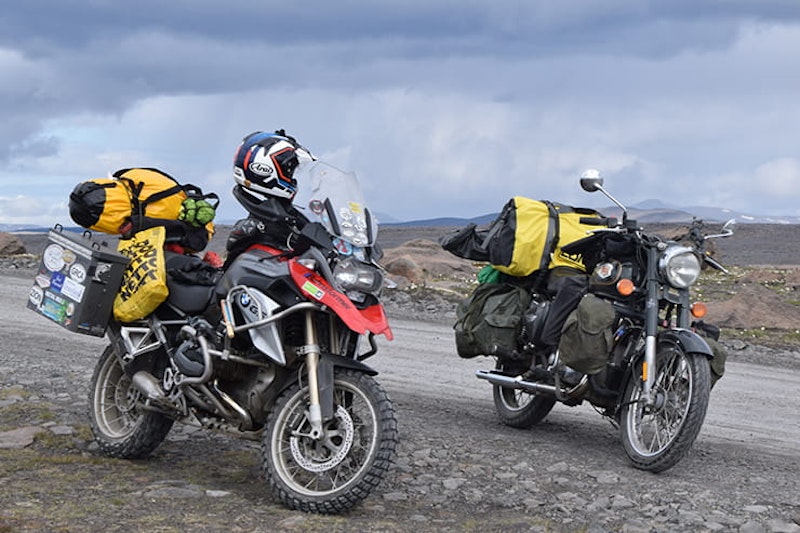Road-riding trips are relatively straight-forward; you generally know the terrain you’re likely to face and the conditions your bike’s going to have to endure. Trail-riding on the other hand involves many more variables, and can be much more demanding on you, and your machine. Not only will it influence the type of bike you’re likely to ride, but it’ll also determine the way you plan your trip, as well as what you take with you and how you carry it...
Can I ride my bike off-road?
Debate rages about what bike is best for trail riding, but when push comes to shove there are a great many machines that can make it up a dirt trail. On the recent Bennetts customer rewards Welsh Safari we had everything from a perfectly-suited Suzuki DRZ400 and Yamaha TTR250, to behemoths such as the BMW R1200GS. And at the other end of the scale, two tiny Honda MSX125s that bobbed along the same trails just fine.
Small-capacity trail bikes are designed to handle the type of rough riding you’re likely to encounter and in reality, are the motorcycles most suited to the job. The bigger adventure bikes are also capable, especially with a good rider on board; for more gentle terrain or flowing surfaces they can surprise you with their ability, but when the going gets tough and the lanes get rocky or rutted then the weight really starts to work against them. In that regard they’re probably not the best bikes for a novice to try their hand at green-laning on, despite what the action-packed promo videos might suggest.
One thing you’re going to have to accept is that when taking your bike off tarmac, the chances of it getting damaged are much higher. It’s so easy to take a tumble and drop the machine; you will pick up scratches and broken plastics.
Having good basic protection such as hand and engine guards helps a lot, and without the right tyres you’re also going to struggle. The basic rule though is that for the novice rider the best bike is the one you can afford to drop and the one that you can best man-handle. Light and cheap is what you ideally need, although with the rising cost of those sorts of trail bikes, nothing is as cheap as it used to be, with sought after machines such as the Suzuki DRZ400 and Yamaha TTR250s often fetching more than £2,000. A newer option is the Honda CRF250L, which is incredibly novice friendly and holds its value well. You can also load it up and have a good weekend away on one.
Your choice of bike can make a big difference
Am I insured to ride off-road?
It’s very important to understand the difference between riding legal byways, and riding off-road. Byways are legal rights of way, and your vehicle must be taxed, insured and have a valid MoT.
Riding off of a road or byway in the UK can only be done with the landowner’s permission, and as it’s private property, your bike most likely won’t be insured. If in any doubt, check the map, and ask your insurer.
Besides insuring your motorcycle, you should consider travel insurance, which can protect your belongings, not to mention help ensure medical care in the event of an accident if you’re overseas. You’ll need to check the terms and conditions, but if you choose a quality bike-specific product like Bennett's motorbike travel insurance, you’ll be able to tailor the policy to suit yourself. Also keep in mind that you could buy an annual policy, which could cover all of your trips, including holidays with the family.
How do I know how tough the trails will be?
The simple answer is that you don’t, unless it’s a familiar trail or you’re riding it with a guide. This adds to the unpredictability of trail riding and is compounded by changes in the weather. Chalky terrain such as that found at Salisbury Plains is very easy for the novice to ride when dry, but in the wet it turns to glass, and unless you’re running aggressive tyres and have a good handle on what you’re doing then you’re going to be on the deck a fair amount. The same goes for the sand of Thetford Forest. The compact gravel and stone of Wales are more all-weather friendly, giving good grip even in the wet.
For a novice rider it probably wouldn’t be advised to go roaming on terrain you’re unfamiliar with. Instead, join your local Trail Riders Fellowship group and learn some basic riding skills along the local terrain, with the regional TRF groups often having open days.
The Irish Paddy and Welsh Taffy Dakars are both good events for the novice rider to get some time on the trails in a relatively controlled environment. This year there was also the Wales 500, the annual Touratech Travel Event – which always has opportunity to ride off road – and the numerous events held at Haggs Bank bunkhouse up in Cumbria, as well as the Horizons Unlimited meet in South Wales.
I would also look to venues such as the Sweet Lamb Adventure Academy, which has plenty of events in the calendar, such as road book or beginner riding weekends.
How do I plan my route?
Planning a trail route is much harder than a road route, especially if you’re travelling a distance away from home, where you’re less likely to know the rideable trails. Linking up with other districts of the Trail Riders Fellowship is a good way to go, as is joining one of the active Facebook groups such as UK Adventure Riders. Other than that, it’s a case of studying and marking out the OS maps to locate the BOATS (Byways Open to All Traffic), of which there are a decreasing number.
Only byways open to all traffic can be ridden legally – find them on an OS map with the line of green crosses
Recently, the Trans European Trail (TET) has been a fantastic initiative, setting out to map a navigable 30,000 mile – largely trail – riding route from one side of Europe to the other, some 1,000 miles of it passing through the UK. The route is free to download from the website, with an active Facebook page designed to help people plan, prepare and then do their own part of the route. The UK section alone can take up to two weeks, but you could pick part of it and do a stretch over the course of a weekend.
Other than that, you really can’t beat heading to the outer regions of the UK, such as mid-Wales or up into Cumbria or Northumberland, where you can access far more of the trail network. Again, look for representatives from the local TRF group or, to make the most of your time, consider hiring a local guide who will you take you on the lanes best suited to you. Last but not least, for those wishing to go further afield, Austin Vince of Mondo Enduro fame hosts trail riding events in the Pyrenees.
How far should I go?
For your first few trips I’d say don’t go too far. Trail riding is more tiring than road riding, especially when you’re new to it and likely to be tense and prone to the odd topple or two.
It also depends on what type of bike you’re riding; if you have a tarmac-friendly dual-sport bike, which tends to be on the larger side, then you can cover some distance on the road before reaching the trails. If you’re riding a small enduro or trail-oriented machine then you’re less likely to want to ride as far on the road, unless you put the bike in a van, which kind of defeats the purpose. Sometimes the lanes most local to you make the most enjoyable weekend.
Where should I stay?
Budget often dictates your preference, with hotels and guesthouses at the top end, down to hostels, bunkhouses and campsites at the other. Personally, for that true sense of adventure, then one of the latter three often fits the bill; you’re more likely to get talking to other travellers, and being among the elements in a camp field – or better still wild camping – all adds to the total experience.
Wild camping takes a bit of nerve and a bit of patience. It’s not strictly legal unless you’re in Scotland, but the principal is to find a nice quiet patch of land where you’re unlikely to be seen or disturbed, set up camp at dusk, get some sleep and be up and away at day break. If you’re a lone rider or a pair then you’re more than likely to get away with it, but it’s not advised for a big group, and a strict etiquette of taking your rubbish with you should be observed.
Haggs Bank bunkhouse in Cumbria is a popular trail rider’s haunt
What should I pack for a weekend on the trails?
Tent
Sleeping bag
Roll mat
Cooking Equipment
Or of course, you could stay in a B&B or guest/bunk house, and eat in a nearby pub.
Waterproofs: A cheap cagoule over your normal kit works well and packs down small
Tools that you know how to use! Puncture repair is the most important.
A Motion Pro tool set, folds down small but still has plenty of features.
Tie wraps
Gaffer tape
Chemical metal, in case you puncture an engine case or something else that needs bodging together.
A tow rope can be handy depending on the severity of the route.
Snacks and fluids
First aid kit and the basic knowledge of what to do in the event of a fall.
Mobile phone
The free Biker Down courses run by fire and other services around the country are a great way of helping to take the panic out of an emergency situation, and make sure someone knows your route and rough itinerary, just in case things do go wrong. People often advise not to ride solo on the trails, but that’s your call to make. Just be careful if you do.
How should I carry everything?
While hard panniers have become the luggage of choice for on-road adventures, soft panniers are less likely to be damaged in a fall. A fixed hard pannier can also, if you’re unlucky, twist and bend your sub-frame, and could be a hazard in a fall.
Soft luggage is also able to be mounted to a variety of bikes without specific pannier frames, though make sure you keep the panniers from the exhaust or rear wheel.
Carrying the weight low in the luggage is best for a balanced bike, and the less stuff you pack the better.
A rucksack is handy for carrying small items, as well as a water bladder, but avoid anything heavy as it’ll strain your back over the course of the day. Tail packs are also good, strapping to your rear rack and giving you ample space for a weekend away in a hotel or bunkhouse.
Last but not least are handy storage solutions such as tool tubes and frame bags that stow away discretely, or cable tying tyre levers and other essentials to parts of the bike such as the frame to save carrying them on your person or in panniers.
It’s all about packing small and smart on a trail ride.
What riding kit do I need for trail riding?
As with road riding, you need to make sure the vulnerable parts are protected – knees, elbow, shoulders – with greater attention paid to foot wear. Sturdy adventure or off-road boots are essential to prevent breaks or sprains when riding on broken surfaces. Eye protection is also crucial, especially when riding in forest areas, where branches could swipe your helmet.
You don’t need a specific adventure helmet to begin with but with the extended chin piece they do give you a bit more space to breath, with the visor handy for keeping the sun out of your eyes. Thin summer gloves help with dexterity, and again, waterproof clothing is a must if you plan on staying warm and dry.
What else do I need?
Navigating on the trails can be a bit of a dark art, especially with the baffling number of mapping tools and methods of plotting a route such as GPX. The go-to system seems to be the Garmin Montana, a navigational device that covers everything and anything mentioned on OS maps. The downside is the price, in the region of £500, leaving people to explore the various phone apps such as Viewranger, to download and plot routes to be used off-line.
Google maps can now also be viewed offline, but often the best way is a marked up OS map, or a GPS route downloaded and shared among riders.
If you’re using a phone then consider an old one as it is likely to get wet, lost or damaged, while a 12V charge point on the bike will be essential to charge it.
Last but not least, take a lock, especially if leaving bikes outside a hotel. Trail bikes are still a common and easy target for bike thieves. Check our buying advice here.
The most important thing you need is the willingness to get stuck in and give it a go. Once you’re up and running with trail riding, it opens up your riding opportunities no end…



